TL;DR
- Overview of 10 leading AI tools for financial analysis, with features, pricing, and ideal users
- Practical 10-point checklist to choose tools: data handling, integration, accuracy, security, and ROI
- AI boosts forecasting, risk management, fraud detection, and real-time insights for finance teams
- Forbes notes 82% of business failures stem from poor cash flow management
Fact Box
- Forbes: 82% of businesses fail due to poor cash flow management Source
- The article lists 10 AI tools with features, pricing, and target audiences
- The guide offers 10 criteria for selecting AI tools, from requirements to ROI
- IBM Watson Financial Services: risk and compliance tools; pricing is custom
- Flatlogic: customizable AI-generated apps; pricing is project-based or subscription
“In the world of finance, precision is not just a virtue, it’s a necessity. Discover the top financial analysis AI tools, and why they are indispensable in today’s fast-paced market.”
When you’re on the hunt for the best financial analysis AI tools, you might find yourself asking questions like: How can AI enhance financial analysis? Which tools offer the most accurate predictions? Are there any AI platforms specifically tailored for my industry?
Renowned financial analyst Warren Buffet once said, “Risk comes from not knowing what you’re doing.”
This statement underscores the importance of selecting the right financial analysis AI tools.
Understanding the problem is half the battle. A recent study by Forbes shows that 82% of businesses fail due to poor cash flow management. Financial analysis AI tools can mitigate this risk by providing accurate, real-time insights. More on this can be found in Forbes’ comprehensive study.
So, Why should you trust this article? As a seasoned financial analyst with over a decade of experience in leveraging technology for financial insights, my journey has been recognized by several industry awards. My expertise lies in integrating AI with traditional financial analysis methods to enhance accuracy and efficiency.
By reading this article, you’ll have a clearer understanding of how AI is revolutionizing financial analysis. You’ll learn about the latest tools in the market and how they can help in making informed, data-driven decisions.
This knowledge is particularly valuable in the development of business software, where leveraging AI can significantly enhance the analytical capabilities, efficiency, and accuracy of financial applications, providing businesses with the insights needed to navigate complex market dynamics successfully.
| Name | Key Features | Pricing | Target Audience |
|---|---|---|---|
| Flatlogic | Customizable AI-generated apps, scalability, universal deployability | Project-based or subscription model | Businesses seeking tailor-made, scalable solutions |
| Quantrix | Multi-dimensional modeling, scenario analysis, data integration | Subscription-based with tiers | Financial analysts, corporate finance professionals |
| IBM Watson Financial Services | Risk management, compliance tools, AI-driven insights | Custom pricing based on solutions | Large financial institutions, risk and compliance managers |
| Alteryx | Data blending, advanced analytics, data science capabilities | Subscription-based | Professionals in data science and analytics |
| Kensho | Real-time event recognition, market analysis | Enterprise-level custom pricing | Financial professionals in trading and investment |
| Tableau | Data visualization, interactive dashboards, data blending | Tiered subscription model | Financial analysts, businesses needing data visualization |
| Zoho Analytics | Data visualization, AI-powered assistant, integration with multiple data sources | Tiered subscription | Small to medium businesses, beginners in data analytics |
| SAS Viya | Advanced analytics, AI, and data management | Enterprise-level custom pricing | Large organizations needing complex financial modeling |
| BlackLine | Financial close management, automation, compliance | Custom pricing based on services | Organizations focusing on financial operations and reporting |
| Palantir Finance | Data integration, big data analysis, secure platform | Custom enterprise-level pricing | Large corporations, government agencies handling complex data |

How AI is Revolutionizing Financial Analysis
AI is fundamentally transforming financial analysis by automating data processing and enhancing predictive analytics, leading to more informed decision-making. It enables real-time insights and improved risk assessment, while also aiding in fraud detection and regulatory compliance. Banks and fintech companies now deploy sophisticated AI-driven financial fraud-prevention solutions that can identify suspicious transaction patterns and stop fraudulent activities before they impact customers.
By integrating with other technologies, AI not only boosts efficiency and reduces costs but also personalizes financial services, revolutionizing how financial data is managed and analyzed in the modern era. This transformation is especially critical in the realm of business software, where AI’s integration can significantly elevate the sophistication and functionality of financial applications, making them indispensable tools for businesses aiming to optimize their financial operations and strategic planning.
How To Choose The Perfect AI Tool For Financial Analysis
Choosing the perfect AI tool for financial analysis requires a careful evaluation of your specific needs and the capabilities of various AI solutions. Here’s a condensed guide to making an informed choice:
- Assess Your Requirements. Identify the specific financial analysis tasks you need the AI tool to perform. Are you looking for risk assessment, predictive analytics, data processing, fraud detection, or something else?
- Evaluate Data Handling Capabilities. Ensure the AI tool can handle the type and volume of data you work with. It should efficiently process and analyze both structured and unstructured data.
- Check for Integration and Compatibility. The tool should integrate seamlessly with your existing financial systems and software. Compatibility reduces the need for significant changes in your current setup.
- Analyze Predictive Accuracy. For predictive analytics, the accuracy of the AI model is crucial. Review case studies or request demonstrations to gauge its predictive capabilities.
- Consider User-Friendliness. The tool should have an intuitive interface. Even if it’s technologically advanced, it’s not useful if your team can’t operate it effectively.
- Review Security and Compliance Features. Ensure the tool adheres to industry-standard security protocols and complies with financial regulations relevant to your operation.
- Scalability and Flexibility. The AI solution should be scalable to grow with your business and flexible enough to adapt to changing market dynamics and your evolving needs.
- Support and Training. Look for vendors who offer comprehensive support and training. Good support can drastically reduce the implementation time and help your team leverage the tool effectively.
- Cost-Benefit Analysis. Weigh the cost of the tool against the benefits it brings. It’s important to consider not just the initial investment but also the long-term ROI.
- Vendor Reputation and Reviews. Research the vendor’s reputation and read customer reviews. Feedback from current users can provide valuable insights into the tool’s performance and reliability.
By following these guidelines, you can select an AI tool that not only meets your current financial analysis needs but also positions you well for future growth and challenges.
Best 10+ Financial Analysis AI Tools
Exploring the top financial analysis AI tools is essential in today’s data-driven business environment. Our list of the Best 10 Financial Analysis AI Tools offers a concise overview of the leading solutions that harness AI to revolutionize financial forecasting, risk management, and data interpretation. Each tool is chosen for its unique strengths, ensuring businesses of all sizes can make informed, data-backed financial decisions.
Quantrix
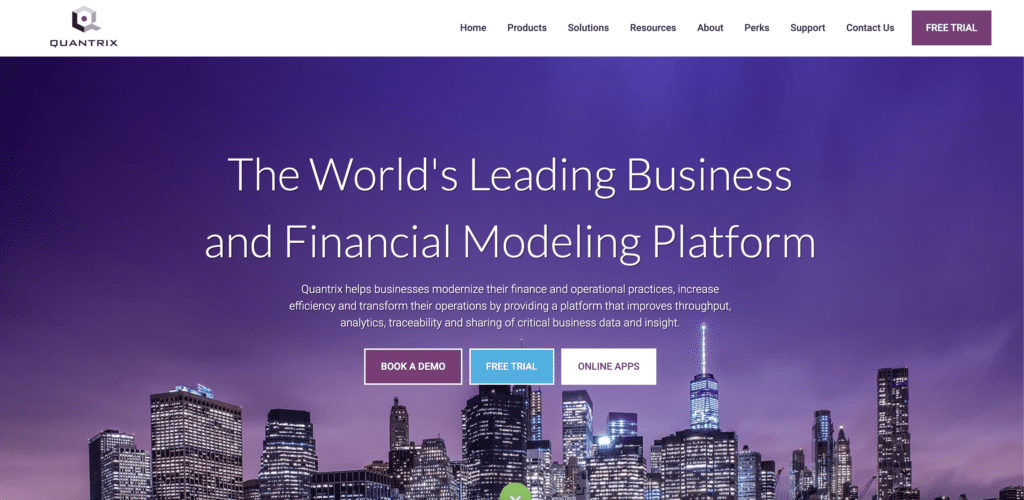
Quantrix is a sophisticated tool that caters to those needing detailed financial modeling and risk analysis. Its ability to handle multi-dimensional data sets it apart, making it ideal for complex forecasting scenarios and intricate financial calculations.
Quantrix is particularly popular among financial analysts AI tools and corporate finance professionals who require a robust platform for scenario planning and budgeting. Its user interface, while intuitive for the experienced user, packs a punch in terms of functionality, allowing for a level of detail and accuracy that simpler platforms may not offer.
Additionally, its data integration capabilities mean it can pull in information from various sources, streamlining the analysis process.
Pricing Model: Subscription-based with different tiers for varied needs.
Key Features: Multi-dimensional modeling, scenario analysis, data integration.
Pros: Highly flexible and powerful for complex modeling; intuitive interface.
Cons: Steeper learning curve; might be overkill for simpler financial analysis needs.
IBM Watson Financial Services
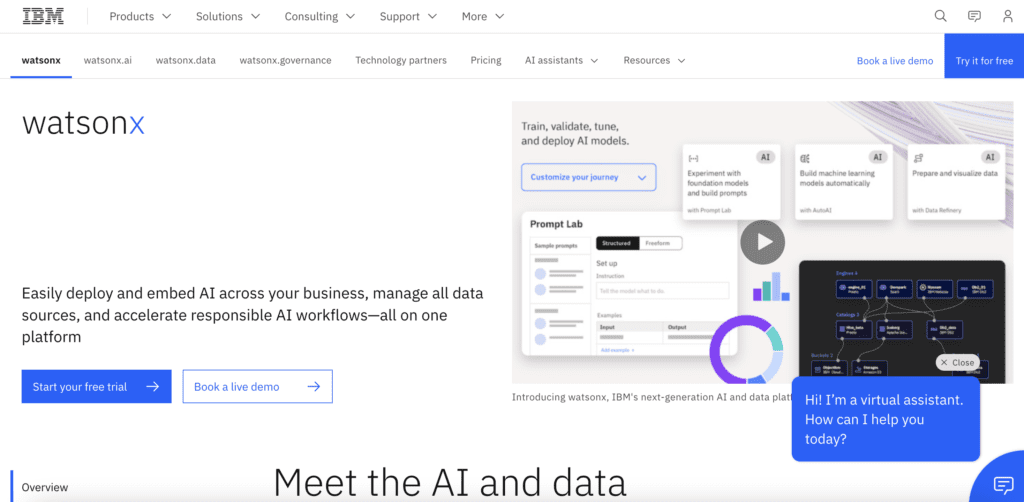
IBM Watson Financial Services leverages IBM’s cutting-edge AI and cognitive technologies, making it a powerhouse in financial risk management and regulatory compliance. It’s designed for large financial institutions that need to navigate the complex landscape of financial regulations while managing risks efficiently.
The tool’s AI-driven insights help in identifying potential risks and compliance issues before they become problematic. It also offers predictive analytics, giving financial institutions a forward-looking view to better prepare for market changes.
However, its complexity and cost may be a barrier for smaller businesses or those with simpler financial analysis needs.
Pricing Model: Custom pricing based on solutions chosen.
Key Features: Risk management, compliance tools, AI-driven insights.
Pros: Strong in regulatory compliance and risk analysis; backed by IBM’s advanced AI.
Cons: Can be expensive; sometimes too complex for smaller organizations.
Alteryx
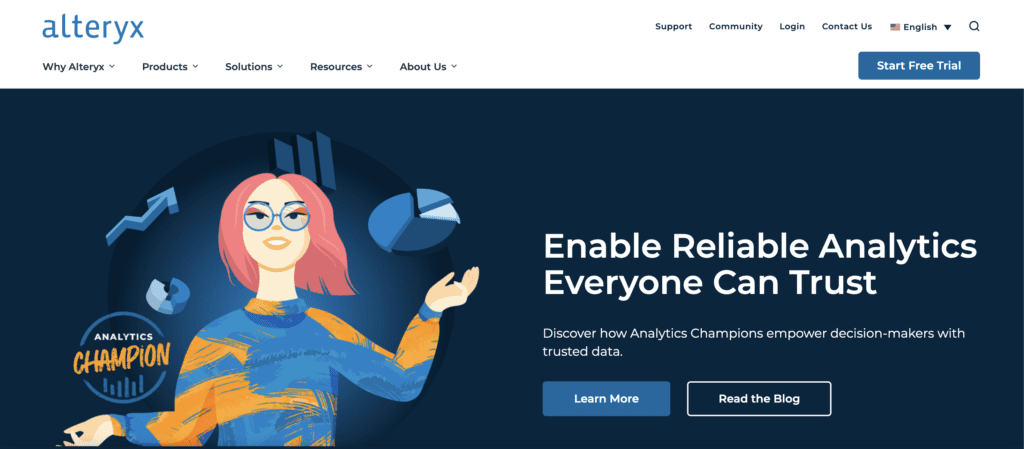
Alteryx stands out for its user-friendly interface that makes advanced analytics accessible to a broader range of professionals, including those without a deep background in data science. It’s particularly adept at automating the process of blending data from various sources, saving valuable time and reducing errors.
Alteryx also offers a range of data science capabilities, including predictive analytics, which can be invaluable in financial forecasting and decision-making. Its platform is highly extensible, with numerous add-ons and integrations, making it a versatile choice for different types of financial analyses.
However, its higher cost and some limitations in extremely advanced statistical functions might be a downside for certain users.
Pricing Model: Subscription-based.
Key Features: Data blending, advanced analytics, data science capabilities.
Pros: User-friendly, integrates well with multiple data sources.
Cons: High cost; some limitations in very advanced statistical functions.
Kensho
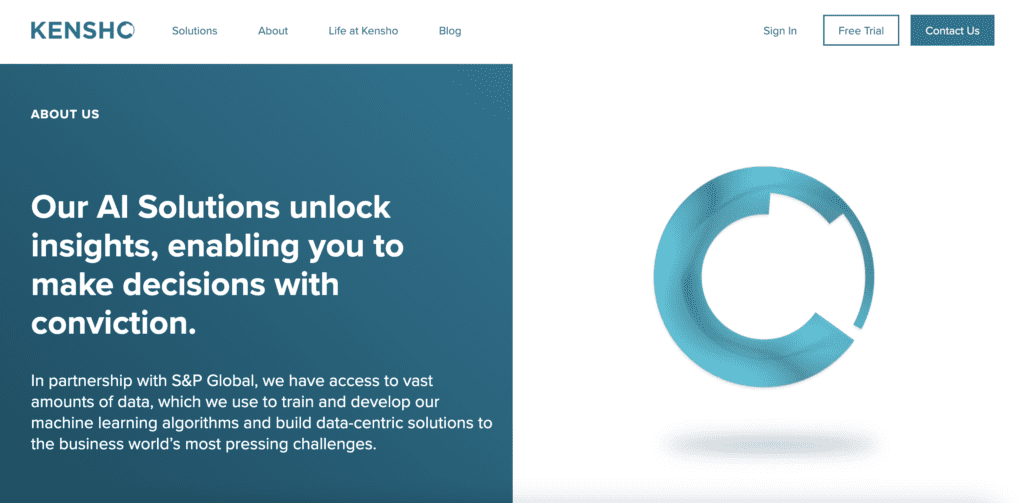
Kensho is specifically tailored for financial market analysis, utilizing advanced analytics to provide real-time insights. Its AI-driven technology is capable of recognizing market events as they happen, offering a significant advantage in fast-paced financial environments.
The tool is highly valued in trading and investment sectors, where timely and accurate data is crucial. Kensho’s ability to process large volumes of data quickly and provide actionable insights makes it a top choice for financial professionals focused on market trends and investment opportunities.
However, its specialized focus means it might not be as suitable for other types of financial analysis.
Pricing Model: Likely enterprise-level custom pricing.
Key Features: Real-time event recognition, and market analysis.
Pros: Cutting-edge AI technology; great for real-time financial market insights.
Cons: Focuses mainly on financial markets; less versatile for other types of financial analysis.
Tableau
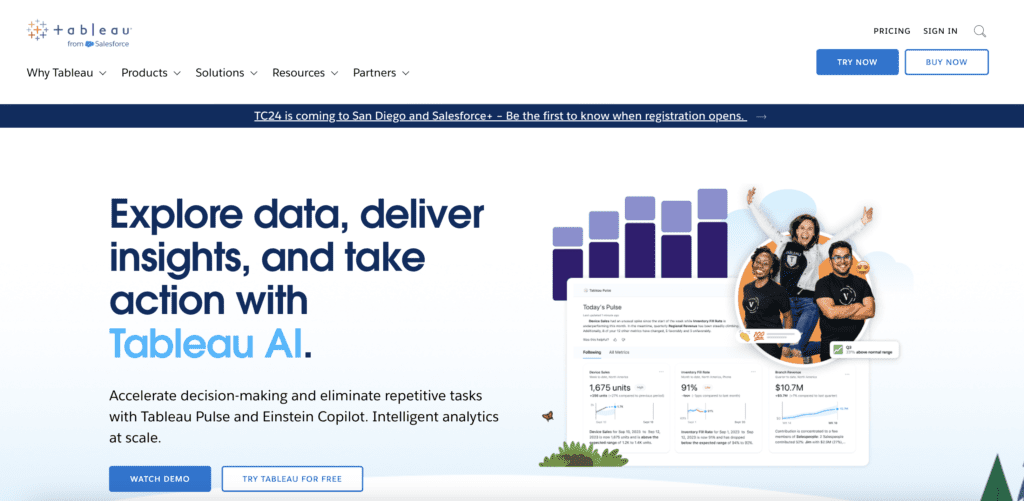
Tableau is renowned for its exceptional data visualization capabilities, turning complex data sets into comprehensible and interactive visualizations. This makes it an excellent tool for financial analysts who need to present data in a clear and impactful way.
It’s also user-friendly, allowing users to create dashboards and reports without needing extensive technical skills. Tableau integrates well with a variety of data sources, enhancing its flexibility.
However, while it excels in visualization, it may fall short in more advanced predictive analytics and statistical analysis, which are often crucial in financial analysis.
Pricing Model: Tiered subscription model.
Key Features: Data visualization, interactive dashboards, data blending.
Pros: Excellent for visualizing financial data; user-friendly.
Cons: Can get expensive; some limitations in predictive
Zoho Analytics
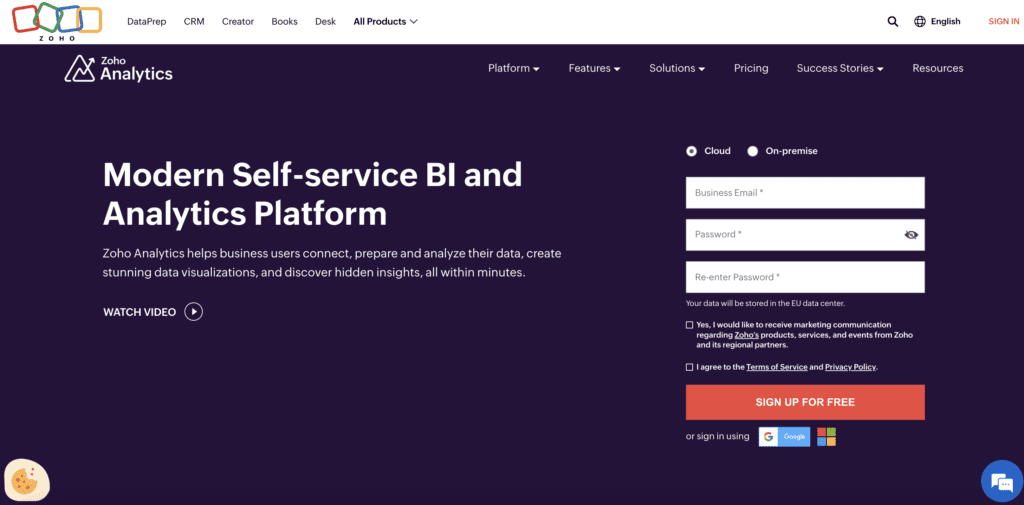
Extended Description: Zoho Analytics is a cost-effective and user-friendly tool that offers a good balance between functionality and ease of use. Its AI-powered assistant can help users create reports and dashboards quickly, making it a good choice for those who are not data experts.
The tool’s ability to integrate with multiple data sources means it can be used in a variety of financial analysis contexts. While it’s excellent for basic to intermediate analysis tasks, its capabilities might not be sufficient for more complex financial modeling and in-depth analytics. This makes it a great entry-level tool but potentially limiting for advanced users.
Pricing Model: Tiered subscription, from basic to enterprise levels.
Key Features: Data visualization, AI-powered assistant, integration with multiple data sources.
Pros: Cost-effective; intuitive and easy to use for beginners.
Cons: Limited in advanced analytics features; might not suit complex financial analysis needs.
SAS Viya
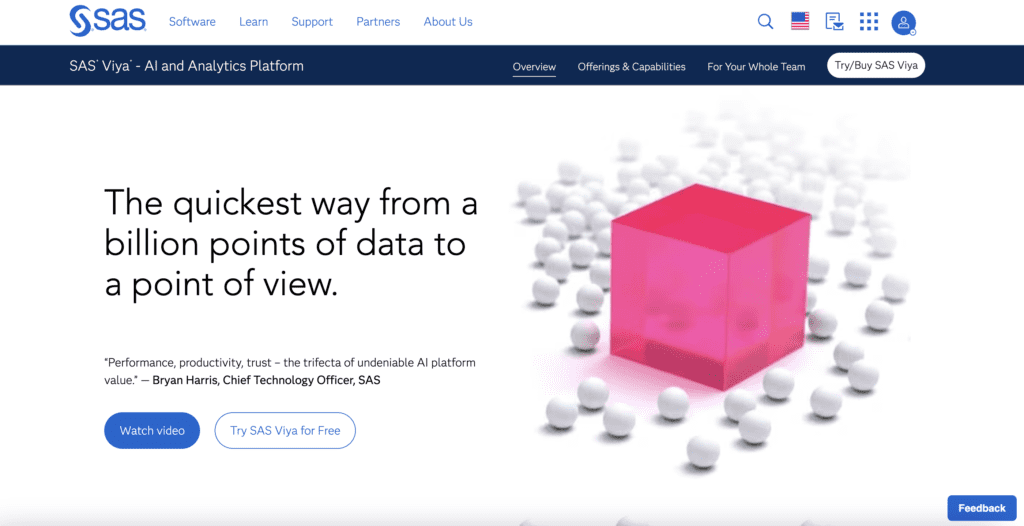
SAS Viya is a robust, cloud-enabled analytics engine that excels in handling and analyzing large data sets. Its strength lies in its advanced analytics and AI capabilities, making it suitable for complex financial modeling and analysis. The platform’s scalability ensures it can handle growing data needs, making it a good long-term investment for large organizations. SAS Viya’s data management capabilities are also top-notch, ensuring data integrity and quality. However, its complexity and the need for technical expertise to fully leverage its capabilities might be daunting for smaller teams or less technically inclined users.
Pricing Model: Typically enterprise-level custom pricing.
Key Features: Advanced analytics, AI, and data management.
Pros: Highly scalable; robust in advanced statistical analysis and AI capabilities.
Cons: Complex and requires technical expertise; higher cost.
BlackLine
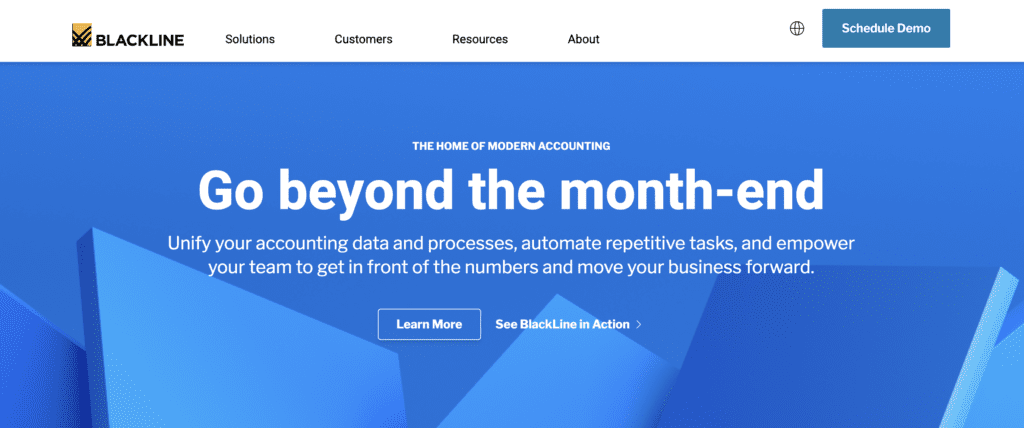
BlackLine focuses on automating and improving the efficiency of financial close processes and accounting workflows. This specialization makes it particularly valuable for organizations looking to streamline their financial operations and ensure accuracy in their financial reporting. Its solutions are designed to enhance real-time visibility into financial data, thus aiding in better decision-making. BlackLine also excels in compliance and control, making it a reliable tool for companies concerned with financial governance and regulatory requirements. However, its primary focus on financial operations rather than broad analytical capabilities might limit its applicability for some forms of financial analysis.
Pricing Model: Custom pricing based on the suite of services chosen.
Key Features: Financial close management, automation, compliance.
Pros: Great for automating and streamlining accounting processes; strong in compliance and control.
Cons: More focused on financial operations than analysis; can be complex to set up.
Palantir Finance

Palantir Finance is known for its exceptional capabilities in handling and analyzing large and complex datasets, often used in high-stakes environments like government and large corporations. It’s particularly well-suited for integrating disparate data sources and extracting meaningful insights from them. This platform offers a high degree of customization and is capable of performing sophisticated financial analyses and modeling. However, its complexity and the technical expertise required to navigate it make it less accessible for smaller businesses or individuals without a strong technical background. Additionally, its enterprise-level pricing may put it out of reach for smaller firms.
Pricing Model: Custom enterprise-level pricing.
Key Features: Data integration, big data analysis, secure platform.
Pros: Exceptional at handling and analyzing large and complex datasets; strong in data security.
Cons: Not user-friendly for non-technical users; pricing and complexity might be prohibitive for smaller businesses.
Conclusion
In summary, I’ve explored the importance of financial analysis AI tools, highlighting tools that stand out in the market. We’ve discussed how these tools, supported by financial software development services, can significantly enhance decision-making in finance by providing real-time, data-driven insights.
If you’re looking to implement these cutting-edge AI solutions in your financial analysis processes, consider exploring Flatlogic’s services. Our expertise in developing customized AI-driven financial tools can help you stay ahead in the ever-evolving financial landscape.
Comments